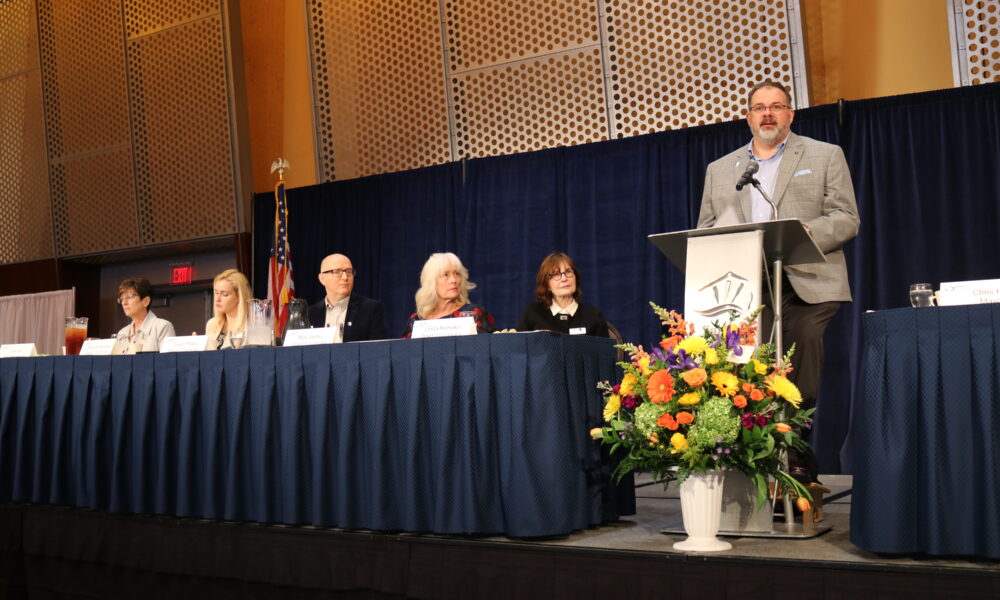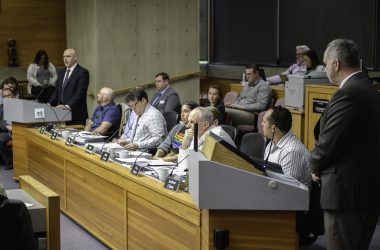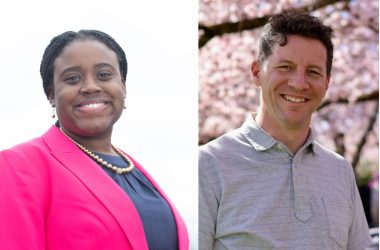Mayor Chris Hoy gave his second State of the City address on Wednesday, March 20, at the Salem Convention Center downtown.
Watch it in English here, or in Spanish here.
Read Salem Reporter’s coverage of the event here:
Below is the full text of the speech, as provided by the city of Salem. It has been reformatted, with light changes to punctuation. Delores Pigsley, chair of the Confederated Tribes of Siletz Indians Tribal Council, gave a blessing before the mayor’s speech.
2024 State of the City
Thank you, Chair Pigsley, for your wonderful invocation and taking the time to join us today.
Good afternoon everyone!
Thank you for being here today. My staff assured me that if we ordered the Moroccan Tagine for lunch, that you would all show up.
Thank you to the sponsors of this annual event: the Salem City Club, Downtown Rotary, and the Salem Area Chamber of Commerce.
Before I begin, I’d like to take this opportunity to share my appreciation and gratitude to several individuals.
First, I’d like to thank the city employees who are here, and those who are also in the field doing their jobs. I could not be more thankful for your work during these last few years, and I could not be more proud of you.
What I have learned over the last seven years serving the city is that we have the best local government employees in the state.
City employees continue to show up to work every day, 24 hours per day and 365 days per year and sometimes they do the work of two or even three people. They complete their work because of their commitment and dedication to serving you, our community.
From the bottom of my heart, I thank them, and I promise to continue to fight for the revenue we need to deliver the services our residents demand.
I’d also like to thank our department directors for the work they do, and I’d like to specifically mention that last month we got a new City Librarian, Bridget Esqueda! Previously she was doing three jobs while Acting in Capacity. Thank you, Bridget!
We are very excited to have your leadership, and I hope that you get to operate a library with all the services befitting the capital city, very soon.
And finally, I’d like to share my appreciation for my colleagues who are with me today:
Council President Virginia Stapleton representing North & Central Salem. Councilor Linda Nishioka representing Central Salem. Councilor Trevor Philips representing Central & Southeast Salem. Councilor Deanna Gwyn representing South Salem. Councilor Jose Gonzalez representing North Salem. Councilor Julie Hoy representing East Salem. Councilor Vanessa Nordyke representing South Salem. Councilor Micki Varney representing West Salem. And joining them on the stage is our highly skilled City Manager, Keith Stahley.
I am happy to report that our local economy is robust and is gaining momentum.
Our new commercial passenger air service is a success. Avelo is seeing a high enough passenger volume that they are making a profit and expanding. They are adding Sonoma, California to the destinations they offer. We are looking forward to the continued economic benefit that the airport brings to our region.
We are also building new large-scale housing developments in all corners of Salem, and we are seeing industrial development and job growth at the Mill Creek Corporate Center and Salem Business Campus, and there are new commercial investments at the Willamette Town Center.
Our downtown continues to see progress with the development of the Rivenwood Apartments, Holman Hotel, and the recent announcement of the development of Block 50, into mixed use housing and shopping.
Additionally, we continue to work with the developer supporting the Front Street Cannery project – a transformational project for the Riverfront north of downtown.
Private investment is excited about Salem’s future.
And Killer Burger came to town. We must be doing something right. But, sadly, still no Burgerville.
We are also demonstrating that Salem cares, we have been able to care for some of the most vulnerable in our community by continuing to advance as a statewide leader in our housing and homeless response.
We have tripled the number of emergency shelter beds, and nearly 80% of ALL affordable housing in Salem has been added in the last five years.
And with a thank you nod to Jimmy Jones and our partners at Arches, we’ve received compliments from the Governor, who said that our Project Turnkey, which turns under-utilized motels into shelters, was being done “better than anywhere else in the state”.
While we have had some amazing successes, our persistent revenue challenges threaten our ability to support these critical services and threaten our hard-won success.
Despite the enormous capabilities of our city employees, and the advances we’ve made in housing and economic development, we are faced with an unprecedented revenue shortfall.
This crisis wasn’t created by city management, city council, or by any of you. It’s a math problem that needs a statewide fix, and until the state fixes it, we will live under a broken revenue system that doesn’t keep up with the rising costs of basic services like police officers, firefighters, and librarians.
We don’t have enough firefighters to handle the astronomical increase in 911 calls since Covid.
We don’t have enough police officers to adequately address the rise in violent crimes, and we certainly don’t have enough for the community outreach that it takes to stop our kids from going down the wrong path to begin with.
Property taxes help the local government pay for public safety. Thirty years ago, Measures 5 and 50 combined to severely limit property tax revenue. Fast forward to today and now those same dollars that used to pay for a firefighter or police officer, only pay for three quarters of one.
How did we get to this point?
When I joined the council in 2017, at the beginning of the homelessness crisis, 26% of Salem residents listed “responding to homelessness” as their top priority. In 2018 it was 33%, then 41, then 49, then in 2021, 58% of residents listed “responding to homelessness” as the number one issue that they wanted Council to address.
Here’s the rub though – cities have no funding mechanism to address homelessness. Cities are set up to provide infrastructure and public safety. We do water, wastewater, streets, parks, police and fire.
Counties are funded to provide social services to residents. They are responsible for Salem residents’ behavioral health treatment, addiction treatment, and public health, and they receive money from the state to address these issues.
But cities like Salem are the first and last line of defense, and when the problem is on Liberty Street and not Cordon Road, our residents expect action from us.
Using one-time grants and Covid relief funds, we were able to step up and address homelessness, but our revenue system has never been adjusted to fund these services annually.
Our residents’ expectations pushed us to explore new partnerships and develop new strategies that reached beyond the capacity of Salem alone.
We teamed up with community partners to create the Mid-Willamette Valley Homeless Alliance, and we partnered with the Mid-Willamette Valley Community Action Agency. We successfully lobbied the State for funds to create a Navigation Center, we partnered with Church at the Park to launch three micro-shelter villages. We created the Salem Outreach and Services Team to go into unmanaged camps, to connect unsheltered residents with the services they need to get off the streets.
We also started a pilot program to help people living in their vehicles repair them so they wouldn’t be towed, and We started a Safe Park program, so individuals living in their vehicles can do so safely and legally.
All of these programs have been launched since 2017, in response to listening to our residents’ wishes.
At the core of the homelessness crisis is the cost and availability of housing. We prioritized streamlining and simplifying the process to better support development.
To continue responding to the needs of the community, City leaders have focused on eliminating barriers in the creation of housing and have worked to eliminate barriers for individuals seeking housing.
For example, we’ve launched a new program that provides the community with free pre-approved building plans for accessory dwelling units. Now Community members can download the plans in English and Spanish on the City’s website.
Like other municipalities, Salem’s permitting function was traditionally split between two departments and multiple divisions. This structure separated and limited collaboration between functions resulting in operational silos that hindered our effectiveness and created inconsistencies in the customer experience.
Developers faced uncertainty and frustration with the permitting process and were dissatisfied with the pace and availability of information.
In response, last year we shifted permitting professionals into one team to build a community-centric culture of service delivery informed by data-driven decisions.
We streamlined Salem’s permitting and will produce more housing, more quickly for our community.
Salem Housing Authority also successfully negotiated with the owners of Orchard Park to preserve the affordability of the 224–unit complex.
Because of these changes, on November 30, 2023, the Salem Housing Authority exceeded our placement goals for the rapid rehousing program we established under Governor Kotek’s executive order. We not only exceeded our placement goals, but also expended only 68% of the budget that was meant for that program.
As a result, we were allowed to continue the program past its original deadline to further benefit our community members.
A quick glance around town will show you that in east Salem, East Park is building 659 single-family homes and 369 apartments.
Northeast Salem is getting a 405-unit apartment complex on Hazelgreen. In south Salem, Mahonia Crossing will offer 313 affordable housing units. In west Salem, Titan Hill is developing 436 units, and three subdivisions near Landau Street are the site of 391 single-family homes.
All in all, there are thousands of apartments, single-family homes, and affordable housing units coming online.
In addition to revenue reform, preventing homelessness, and increasing housing, we are also laser-focused on responding to a rising rate in violent crimes through our Community Violence Reduction Initiative.
Last year, Chief Womack and I began meeting to discuss how the City should address the increase in violent crime. The first task was to understand, in detail, what was going on and where.
We commissioned a study, and those findings were presented in a joint City and Marion County work session in November.
During that work session, I promised that we would engage with the community to identify solutions, and I’m happy to report that we brought our community together for the first of these conversations on March 6th, and are planning three more.
The goal of these meetings is to increase awareness, identify community stakeholders and partners, and
to develop prevention and intervention strategies that reach beyond law enforcement.
Law enforcement is only one piece of the solution. The rest must come from the community. As we have done to address our housing challenges, we need to forge partnerships and enlist our residents, not for profits, service organizations and businesses in strategies designed to help prevent violent crime.
When I was on this stage a year ago, I spoke about a new beginning for Salem. A vision of collaboration with city councilors, interest groups, businesses, and residents.
Like mayors before me, I reported on the amazing work of our city employees and of our volunteer council, and then delivered information on the delicate state of our revenue situation.
I shared with you that without significant help from our county and state partners, or significant public investment, we would no longer be able to provide services to our unsheltered population,
we would not have enough firefighters to adequately respond to emergency calls, and that we would not be able to address and reduce a growing violent crime rate.
I explained how thirty years ago Measures 5 and 50 capped property taxes, resulting in today’s costs being beyond the revenue we can capture. Leaving us with two choices: find additional revenue, or reduce services.
Fast forward to today and we continue to fight for additional revenue to support our residents’ needs.
We continue to leverage every possible opportunity to lobby our state and federal legislators, as well as the Governor’s office. We’ve been successful in obtaining grants, and one-time funding that benefit the city, but we continue to wait for those same leaders to deliver results to our residents through a Payment in Lieu of Taxes, to address the ongoing costs related to homelessness, and in the revenue reform that will provide us with sufficient public safety infrastructure to keep you safe.
We have a revenue taskforce of volunteers from around the city that is hard at work, identifying funding that will help us address our short-term problems.
This taskforce is representative of the entire community and has members from every ward. There are no elected officials on it, and a third party is facilitating it. I thank them for their work, and urge our community to support the outcome of the process.
And so, the road ahead is challenging. Its path is unknown, and our destination is not obvious, but we have faced challenges before.
When our community faced Covid; our residents sewed masks and supported businesses. When a four-alarm fire scorched St Joseph’s Church in the early morning, over 200 people in our community held mass in the afternoon rain, beside it. When a fire started on Jory Hill last summer, employees from Emery & Sons Construction, who were working nearby, steered their heavy equipment towards the flames. The fire lines they cut earned the compliments of Salem Emergency Manager Joe Hutchinson, who credited them with “saving a good chunk of the community.”
And thirteen days ago, when the unimaginable happened in Bush Park, bystanders from our community and first responders, sprang into action to save lives.
Our community responds to adversity with strength. Our community responds to challenges with perseverance. We will protect what we must. And we will find solutions together. As a united community we will emerge well on our way to becoming the vibrant and robust Salem we envision.
Thank you.
Contact reporter Abbey McDonald: [email protected] or 503-575-1251
SUPPORT OUR WORK – We depend on subscribers for resources to report on Salem with care and depth, fairness and accuracy. Subscribe today to get our daily newsletters and more. Click I want to subscribe!
Abbey McDonald joined the Salem Reporter in 2022. She previously worked as the business reporter at The Astorian, where she covered labor issues, health care and social services. A University of Oregon grad, she has also reported for the Malheur Enterprise, The News-Review and Willamette Week.









